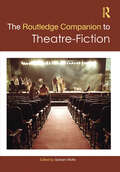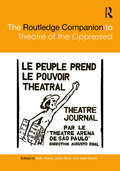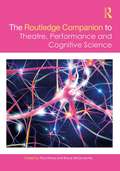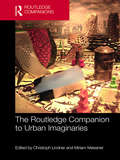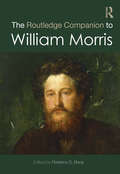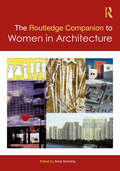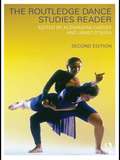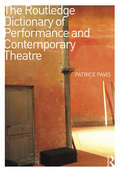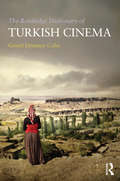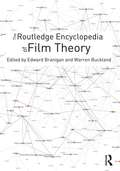- Table View
- List View
The Routledge Companion to Theatre-Fiction (Routledge Literature Handbooks)
Novelists have long been attracted to theatre. Some have pursued success on the stage, but many have sought to combine these worlds, entering theatre through their fiction, setting stages on their novels’ pages, and casting actors, directors, and playwrights as their protagonists. The Routledge Companion to Theatre-Fiction has convened an international community of scholars to explore the remarkable array of novelists from many eras and parts of the world who have created fiction from the stuff of theatre, asking what happens to theatre on the pages of novels, and what happens to novels when they collaborate with theatre. From J. W. Goethe to Louisa May Alcott, Mikhail Bulgakov, Virginia Woolf, and Margaret Atwood, some of history’s most influential novelists have written theatre-fiction, and this Companion discusses many of these figures from new angles. But it also spotlights writers who have received less critical attention, such as Dorothy Leighton, Agustín de Rojas Villandrando, Ronald Firbank, Syed Mustafa Siraj, Li Yu, and Vicente Blasco Ibañez, bringing their work into conversation with a vital field. A valuable resource for students, scholars, and admirers of both theatre and novels, The Routledge Companion to Theatre-Fiction offers a wealth of new perspectives on topics of increasing critical concern, including intermediality, theatricality, antitheatricality, mimesis, diegesis, and performativity.
The Routledge Companion to Theatre of the Oppressed (Routledge Companions)
by Julian Boal Kelly Howe José SoeiroThis dynamic book offers a comprehensive companion to the theory and practice of Theatre of the Oppressed. Developed by Brazilian director and theorist Augusto Boal, these theatrical forms invite people to mobilize their knowledge and rehearse struggles against oppression. Featuring a diverse array of voices (many of them as yet unheard in the academic world), the book hosts dialogues on the following questions, among others: Why and how did Theatre of the Oppressed develop? What are the differences between the 1970s (when Theatre of the Oppressed began) and today? How has Theatre of the Oppressed been shaped by local and global shifts of the last 40-plus years? Why has Theatre of the Oppressed spread or "multiplied" across so many geographic, national, and cultural borders? How has Theatre of the Oppressed been shaped by globalization, "development," and neoliberalism? What are the stakes, challenges, and possibilities of Theatre of the Oppressed today? How can Theatre of the Oppressed balance practical analysis of what is with ambitious insistence on what could be? How can Theatre of the Oppressed hope, but concretely? Broad in scope yet rich in detail, The Routledge Companion to Theatre of the Oppressed contains practical and critical content relevant to artists, activists, teachers, students, and researchers.
The Routledge Companion to Theatre of the Oppressed (Routledge Companions)
by Kelly Howe Julian Boal José SoeiroThis dynamic book offers a comprehensive companion to the theory and practice of Theatre of the Oppressed. Developed by Brazilian director and theorist Augusto Boal, these theatrical forms invite people to mobilize their knowledge and rehearse struggles against oppression. Featuring a diverse array of voices (many of them as yet unheard in the academic world), the book hosts dialogues on the following questions, among others: Why and how did Theatre of the Oppressed develop? What are the differences between the 1970s (when Theatre of the Oppressed began) and today? How has Theatre of the Oppressed been shaped by local and global shifts of the last 40-plus years? Why has Theatre of the Oppressed spread or "multiplied" across so many geographic, national, and cultural borders? How has Theatre of the Oppressed been shaped by globalization, "development," and neoliberalism? What are the stakes, challenges, and possibilities of Theatre of the Oppressed today? How can Theatre of the Oppressed balance practical analysis of what is with ambitious insistence on what could be? How can Theatre of the Oppressed hope, but concretely? Broad in scope yet rich in detail, The Routledge Companion to Theatre of the Oppressed contains practical and critical content relevant to artists, activists, teachers, students, and researchers.
The Routledge Companion to Theatre, Performance and Cognitive Science (Routledge Companions)
by Rick Kemp Bruce McConachieThe Routledge Companion to Theatre, Performance and Cognitive Science integrates key findings from the cognitive sciences (cognitive psychology, neuroscience, evolutionary studies and relevant social sciences) with insights from theatre and performance studies. This rapidly expanding interdisciplinary field dynamically advances critical and theoretical knowledge, as well as driving innovation in practice. The anthology includes 30 specially commissioned chapters, many written by authors who have been at the cutting-edge of research and practice in the field over the last 15 years. These authors offer many empirical answers to four significant questions: How can performances in theatre, dance and other media achieve more emotional and social impact? How can we become more adept teachers and learners of performance both within and outside of classrooms? What can the cognitive sciences reveal about the nature of drama and human nature in general? How can knowledge transfer, from a synthesis of science and performance, assist professionals such as nurses, care-givers, therapists and emergency workers in their jobs? A wide-ranging and authoritative guide, The Routledge Companion to Theatre, Performance and Cognitive Science is an accessible tool for not only students, but practitioners and researchers in the arts and sciences as well.
The Routledge Companion to Theatre, Performance and Cognitive Science (Routledge Companions)
by Rick Kemp Bruce McConachieThe Routledge Companion to Theatre, Performance and Cognitive Science integrates key findings from the cognitive sciences (cognitive psychology, neuroscience, evolutionary studies and relevant social sciences) with insights from theatre and performance studies. This rapidly expanding interdisciplinary field dynamically advances critical and theoretical knowledge, as well as driving innovation in practice. The anthology includes 30 specially commissioned chapters, many written by authors who have been at the cutting-edge of research and practice in the field over the last 15 years. These authors offer many empirical answers to four significant questions: How can performances in theatre, dance and other media achieve more emotional and social impact? How can we become more adept teachers and learners of performance both within and outside of classrooms? What can the cognitive sciences reveal about the nature of drama and human nature in general? How can knowledge transfer, from a synthesis of science and performance, assist professionals such as nurses, care-givers, therapists and emergency workers in their jobs? A wide-ranging and authoritative guide, The Routledge Companion to Theatre, Performance and Cognitive Science is an accessible tool for not only students, but practitioners and researchers in the arts and sciences as well.
The Routledge Companion to Twentieth Century British Theatre and Performance: Volume One: 1900–1950 (Routledge Companions)
by Claire Cochrane Lynette Goddard Catherine Hindson Trish ReidThe Routledge Companion to Twentieth Century British Theatre and Performance provides a broad range of perspectives on the multiple models and examples of theatre, artists, enthusiasts, enablers, and audiences that emerged over this formative 100-year period.This first volume covers the first half of the century, constructing an equitable and inclusive history that is more representative of the nation's lived experience than the traditional narratives of British theatre. Its approach is intra-national – weaving together the theatres and communities of England, Scotland, Wales, and Northern Ireland. The essays are organised thematically arranged into sections that address nation, power, and identity; fixity and mobility; bodies in performance; the materiality of theatre and communities of theatre. This approach highlights the synergies, convergences, and divergences of the theatre landscape in Britain during this period, giving a sense of the sheer variety of performance that was taking place at any given moment in time.This is a fascinating and indispensable resource for undergraduate and graduate students, postgraduate researchers, and scholars across theatre and performance studies, cultural studies, and twentieth-century history.
The Routledge Companion to Twentieth Century British Theatre and Performance: Volume One: 1900–1950 (Routledge Companions)
The Routledge Companion to Twentieth Century British Theatre and Performance provides a broad range of perspectives on the multiple models and examples of theatre, artists, enthusiasts, enablers, and audiences that emerged over this formative 100-year period.This first volume covers the first half of the century, constructing an equitable and inclusive history that is more representative of the nation's lived experience than the traditional narratives of British theatre. Its approach is intra-national – weaving together the theatres and communities of England, Scotland, Wales, and Northern Ireland. The essays are organised thematically arranged into sections that address nation, power, and identity; fixity and mobility; bodies in performance; the materiality of theatre and communities of theatre. This approach highlights the synergies, convergences, and divergences of the theatre landscape in Britain during this period, giving a sense of the sheer variety of performance that was taking place at any given moment in time.This is a fascinating and indispensable resource for undergraduate and graduate students, postgraduate researchers, and scholars across theatre and performance studies, cultural studies, and twentieth-century history.
The Routledge Companion to Urban Imaginaries (Routledge International Handbooks)
by Christoph Lindner Miriam MeissnerThe Routledge Companion to Urban Imaginaries delves into examples of urban imaginaries across multiple media and geographies: from new visions of smart, eco, and resilient cities to urban dystopias in popular culture; from architectural renderings of starchitecture and luxury living to performative activism for new spatial justice; and from speculative experiments in urban planning, fiction, and photography to augmented urban realities in crowd-mapping and mobile apps. The volume brings various global perspectives together and into close dialogue to offer a broad, interdisciplinary, and critical overview of the current state of research on urban imaginaries. Questioning the politics of urban imagination, the companion gives particular attention to the role that urban imaginaries play in shaping the future of urban societies, communities, and built environments. Throughout the companion, issues of power, resistance, and uneven geographical development remain central. Adopting a transnational perspective, the volume challenges research on urban imaginaries from the perspective of globalization and postcolonial studies, inviting critical reconsiderations of urbanism in its diverse current forms and definitions. In the process, the companion explores issues of Western-centrism in urban research and design, and accommodates current attempts to radically rethink urban form and experience. This is an essential resource for scholars and graduate researchers in the fields of urban planning and architecture; art, media, and cultural studies; film, visual, and literary studies; sociology and political science; geography; and anthropology.
The Routledge Companion to Urban Imaginaries (Routledge International Handbooks)
by Christoph Lindner Miriam MeissnerThe Routledge Companion to Urban Imaginaries delves into examples of urban imaginaries across multiple media and geographies: from new visions of smart, eco, and resilient cities to urban dystopias in popular culture; from architectural renderings of starchitecture and luxury living to performative activism for new spatial justice; and from speculative experiments in urban planning, fiction, and photography to augmented urban realities in crowd-mapping and mobile apps. The volume brings various global perspectives together and into close dialogue to offer a broad, interdisciplinary, and critical overview of the current state of research on urban imaginaries. Questioning the politics of urban imagination, the companion gives particular attention to the role that urban imaginaries play in shaping the future of urban societies, communities, and built environments. Throughout the companion, issues of power, resistance, and uneven geographical development remain central. Adopting a transnational perspective, the volume challenges research on urban imaginaries from the perspective of globalization and postcolonial studies, inviting critical reconsiderations of urbanism in its diverse current forms and definitions. In the process, the companion explores issues of Western-centrism in urban research and design, and accommodates current attempts to radically rethink urban form and experience. This is an essential resource for scholars and graduate researchers in the fields of urban planning and architecture; art, media, and cultural studies; film, visual, and literary studies; sociology and political science; geography; and anthropology.
The Routledge Companion to Vsevolod Meyerhold (Routledge Companions)
by Jonathan Pitches Stefan AquilinaThe Routledge Companion to Vsevolod Meyerhold brings together a wealth of scholarship on one of the foremost innovators in European theatre. It presents a detailed picture of the Russian director’s work from when it first emerged on the modern stage to its multifarious present-day manifestations. By combining an historical focus with the latest contemporary research from an international range of perspectives and authors, this collection marks an important moment in Meyerhold studies as well as offering a new assessment of his relation to today's theatre-making. Its dynamic blend of research is presented in five sections: Histories enlarges on more conventional subjects like the grotesque and Biomechanics, to overlooked topics such as Meyerhold's ‘failed’ projects and his work in film; Collaborations and Connections extends understandings of Meyerhold’s well-known collaborative capacities to consider new cultural influences and lesser known working relationships; Sources engages with hitherto untapped material in Meyerhold’s oeuvre by reproducing and contextualising previously untranslated primary sources on his work; Practitioner Voices offer lively, on the ground, testimony of the contemporary impact of Meyerhold's practice; Meyerhold in New Contexts maps the routes of his practice across continents and examines ways in which his work is being applied in a number of contemporary scenarios, such as motion capture, computer-based 3D visualisations, and the ‘new normal’ of digital pedagogy. This is a key resource for students and scholars of European Theatre, acting theory, and actor training, as well as for those more broadly interested in the socio-political impact of theatre.
The Routledge Companion to Vsevolod Meyerhold (Routledge Companions)
by Jonathan Pitches Stefan AquilinaThe Routledge Companion to Vsevolod Meyerhold brings together a wealth of scholarship on one of the foremost innovators in European theatre. It presents a detailed picture of the Russian director’s work from when it first emerged on the modern stage to its multifarious present-day manifestations. By combining an historical focus with the latest contemporary research from an international range of perspectives and authors, this collection marks an important moment in Meyerhold studies as well as offering a new assessment of his relation to today's theatre-making. Its dynamic blend of research is presented in five sections: Histories enlarges on more conventional subjects like the grotesque and Biomechanics, to overlooked topics such as Meyerhold's ‘failed’ projects and his work in film; Collaborations and Connections extends understandings of Meyerhold’s well-known collaborative capacities to consider new cultural influences and lesser known working relationships; Sources engages with hitherto untapped material in Meyerhold’s oeuvre by reproducing and contextualising previously untranslated primary sources on his work; Practitioner Voices offer lively, on the ground, testimony of the contemporary impact of Meyerhold's practice; Meyerhold in New Contexts maps the routes of his practice across continents and examines ways in which his work is being applied in a number of contemporary scenarios, such as motion capture, computer-based 3D visualisations, and the ‘new normal’ of digital pedagogy. This is a key resource for students and scholars of European Theatre, acting theory, and actor training, as well as for those more broadly interested in the socio-political impact of theatre.
The Routledge Companion to William Morris (Routledge Art History and Visual Studies Companions)
by Florence S. BoosWilliam Morris (1834–96) was an English poet, decorative artist, translator, romance writer, book designer, preservationist, socialist theorist, and political activist, whose admirers have been drawn to the sheer intensity of his artistic endeavors and efforts to live up to radical ideals of social justice. This Companion draws together historical and critical responses to the impressive range of Morris’s multi-faceted life and activities: his homes, travels, family, business practices, decorative artwork, poetry, fantasy romances, translations, political activism, eco-socialism, and book collecting and design. Each chapter provides valuable historical and literary background information, reviews relevant opinions on its subject from the late-nineteenth century to the present, and offers new approaches to important aspects of its topic. Morris’s eclectic methodology and the perennial relevance of his insights and practice make this an essential handbook for those interested in art history, poetry, translation, literature, book design, environmentalism, political activism, and Victorian and utopian studies.
The Routledge Companion to William Morris (Routledge Art History and Visual Studies Companions)
by Florence S. BoosWilliam Morris (1834–96) was an English poet, decorative artist, translator, romance writer, book designer, preservationist, socialist theorist, and political activist, whose admirers have been drawn to the sheer intensity of his artistic endeavors and efforts to live up to radical ideals of social justice. This Companion draws together historical and critical responses to the impressive range of Morris’s multi-faceted life and activities: his homes, travels, family, business practices, decorative artwork, poetry, fantasy romances, translations, political activism, eco-socialism, and book collecting and design. Each chapter provides valuable historical and literary background information, reviews relevant opinions on its subject from the late-nineteenth century to the present, and offers new approaches to important aspects of its topic. Morris’s eclectic methodology and the perennial relevance of his insights and practice make this an essential handbook for those interested in art history, poetry, translation, literature, book design, environmentalism, political activism, and Victorian and utopian studies.
The Routledge Companion to Women in Architecture
by Anna SokolinaThe Routledge Companion to Women in Architecture illuminates the names of pioneering women who over time continue to foster, shape, and build cultural, spiritual, and physical environments in diverse regions around the globe. It uncovers the remarkable evolution of women’s leadership, professional perspectives, craftsmanship, and scholarship in architecture from the preindustrial age to the present.The book is organized chronologically in five parts, outlining the stages of women’s expanding engagement, leadership, and contributions to architecture through the centuries. It contains twenty-nine chapters written by thirty-three recognized scholars committed to probing broader topographies across time and place and presenting portraits of practicing architects, leaders, teachers, writers, critics, and other kinds of professionals in the built environment. The intertwined research sets out debates, questions, and projects around women in architecture, stimulates broader studies and discussions in emerging areas, and becomes a catalyst for academic programs and future publications on the subject.The novelty of this volume is in presenting not only a collection of case studies but in broadening the discipline by advancing an incisive overview of the topic as a whole. It is an invaluable resource for architectural historians, academics, students, and professionals.
The Routledge Companion to Women in Architecture
by Anna SokolinaThe Routledge Companion to Women in Architecture illuminates the names of pioneering women who over time continue to foster, shape, and build cultural, spiritual, and physical environments in diverse regions around the globe. It uncovers the remarkable evolution of women’s leadership, professional perspectives, craftsmanship, and scholarship in architecture from the preindustrial age to the present.The book is organized chronologically in five parts, outlining the stages of women’s expanding engagement, leadership, and contributions to architecture through the centuries. It contains twenty-nine chapters written by thirty-three recognized scholars committed to probing broader topographies across time and place and presenting portraits of practicing architects, leaders, teachers, writers, critics, and other kinds of professionals in the built environment. The intertwined research sets out debates, questions, and projects around women in architecture, stimulates broader studies and discussions in emerging areas, and becomes a catalyst for academic programs and future publications on the subject.The novelty of this volume is in presenting not only a collection of case studies but in broadening the discipline by advancing an incisive overview of the topic as a whole. It is an invaluable resource for architectural historians, academics, students, and professionals.
The Routledge Dance Studies Reader
by Jens Richard Giersdorf Yutian WongThe Routledge Dance Studies Reader has been expanded and updated, giving readers access to thirty-seven essential texts that address the social, political, cultural, and economic impact of globalization on embodiment and choreography. These interdisciplinary essays in dance scholarship consider a broad range of dance forms in relation to historical, ethnographic, and interdisciplinary research methods including cultural studies, reconstruction, media studies, and popular culture. This new third edition expands both its geographic and cultural focus to include recent research on dance from Southeast Asia, the People’s Republic of China, indigenous dance, and new sections on market forces and mediatization. Sections cover: Methods and approaches Practice and performance Dance as embodied ideology Dance on the market and in the media Formations of the field. The Routledge Dance Studies Reader includes essays on concert dance (ballet, modern and postmodern dance, tap, kathak, and classical khmer dance), popular dance (salsa and hip-hop), site-specific performance, digital choreography, and lecture-performances. It is a vital resource for anyone interested in understanding dance from a global and contemporary perspective.
The Routledge Dance Studies Reader
by Jens Richard Giersdorf Yutian WongThe Routledge Dance Studies Reader has been expanded and updated, giving readers access to thirty-seven essential texts that address the social, political, cultural, and economic impact of globalization on embodiment and choreography. These interdisciplinary essays in dance scholarship consider a broad range of dance forms in relation to historical, ethnographic, and interdisciplinary research methods including cultural studies, reconstruction, media studies, and popular culture. This new third edition expands both its geographic and cultural focus to include recent research on dance from Southeast Asia, the People’s Republic of China, indigenous dance, and new sections on market forces and mediatization. Sections cover: Methods and approaches Practice and performance Dance as embodied ideology Dance on the market and in the media Formations of the field. The Routledge Dance Studies Reader includes essays on concert dance (ballet, modern and postmodern dance, tap, kathak, and classical khmer dance), popular dance (salsa and hip-hop), site-specific performance, digital choreography, and lecture-performances. It is a vital resource for anyone interested in understanding dance from a global and contemporary perspective.
The Routledge Dance Studies Reader
by Jens Giersdorf Yutian WongThe second edition of The Routledge Dance Studies Reader offers fresh critical perspectives on classic and modern dance forms, including ballroom, tango, Hip-hop, site-specific performance, and disability in dance. Alexandra Carter and Janet O’Shea deliver a substantially revised and updated collection of key texts, featuring an enlightening new introduction, which tracks differing approaches to dance studies. Important articles from the first edition are accompanied by twenty new works by leading critical voices. The articles are presented in five thematic sections, each with a new editorial introduction and further reading. Sections cover: Making dance Performing dance Ways of looking Locating dance in history and society Debating the discipline The Routledge Dance Studies Reader gives readers access to over thirty essential texts on dance and provides expert guidance on their critical context. It is a vital resource for anyone interested in understanding dance from a global and contemporary perspective.
The Routledge Dance Studies Reader
by Jens Giersdorf Yutian WongThe second edition of The Routledge Dance Studies Reader offers fresh critical perspectives on classic and modern dance forms, including ballroom, tango, Hip-hop, site-specific performance, and disability in dance. Alexandra Carter and Janet O’Shea deliver a substantially revised and updated collection of key texts, featuring an enlightening new introduction, which tracks differing approaches to dance studies. Important articles from the first edition are accompanied by twenty new works by leading critical voices. The articles are presented in five thematic sections, each with a new editorial introduction and further reading. Sections cover: Making dance Performing dance Ways of looking Locating dance in history and society Debating the discipline The Routledge Dance Studies Reader gives readers access to over thirty essential texts on dance and provides expert guidance on their critical context. It is a vital resource for anyone interested in understanding dance from a global and contemporary perspective.
The Routledge Dance Studies Reader (PDF)
by Janet O’shea Alexandra CarterThe second edition of The Routledge Dance Studies Reader offers fresh critical perspectives on classic and modern dance forms, including ballroom, tango, Hip-hop, site-specific performance, and disability in dance. Alexandra Carter and Janet O'Shea deliver a substantially revised and updated collection of key texts, featuring an enlightening new introduction, which tracks differing approaches to dance studies. Important articles from the first edition are accompanied by twenty new works by leading critical voices. The articles are presented in five thematic sections, each with a new editorial introduction and further reading. Sections cover: Making dance Performing dance Ways of looking Locating dance in history and society Debating the discipline The Routledge Dance Studies Reader gives readers access to over thirty essential texts on dance and provides expert guidance on their critical context. It is a vital resource for anyone interested in understanding dance from a global and contemporary perspective.nbsp;
The Routledge Dictionary of Performance and Contemporary Theatre
by Patrice PavisThe Routledge Dictionary of Contemporary Theatre and Performance provides the first authoritative alphabetical guide to the theatre and performance of the last 30 years. Conceived and written by one of the foremost scholars and critics of theatre in the world, it literally takes us from Activism to Zapping, analysing everything along the way from Body Art and the Flashmob to Multimedia and the Postdramatic. What we think of as 'performance' and 'drama' has undergone a transformation in recent decades. Similarly how these terms are defined, used and critiqued has also changed, thanks to interventions from a panoply of theorists from Derrida to Ranciere. Patrice Pavis's Dictionary provides an indispensible roadmap for this complex and fascinating terrain; a volume no theatre bookshelf can afford to be without.
The Routledge Dictionary of Performance and Contemporary Theatre
by Patrice PavisThe Routledge Dictionary of Contemporary Theatre and Performance provides the first authoritative alphabetical guide to the theatre and performance of the last 30 years. Conceived and written by one of the foremost scholars and critics of theatre in the world, it literally takes us from Activism to Zapping, analysing everything along the way from Body Art and the Flashmob to Multimedia and the Postdramatic. What we think of as 'performance' and 'drama' has undergone a transformation in recent decades. Similarly how these terms are defined, used and critiqued has also changed, thanks to interventions from a panoply of theorists from Derrida to Ranciere. Patrice Pavis's Dictionary provides an indispensible roadmap for this complex and fascinating terrain; a volume no theatre bookshelf can afford to be without.
The Routledge Dictionary of Turkish Cinema
by Gonul Donmez-ColinThe first critical and analytical dictionary of Turkish Cinema, this book provides a comprehensive overview of Turkish cinema from its beginnings to the present day. Addressing the lacuna in scholarly work on the topic, this dictionary provides immense detail on a wide range of aspects of Turkish cinema including; prominent filmmakers, films, actors, screenwriters, cinematographers, editors, producers, significant themes, genres, movements, theories, production modes, film journals, film schools and professional organizations. Extensively researched, elaborately detailed and written in a remarkably readable style, the Routledge Dictionary of Turkish Cinema will be invaluable for film scholars and researchers as a reference book and as a guide to the dynamics of the cinema of Turkey.
The Routledge Dictionary of Turkish Cinema
by Gonul Donmez-ColinThe first critical and analytical dictionary of Turkish Cinema, this book provides a comprehensive overview of Turkish cinema from its beginnings to the present day. Addressing the lacuna in scholarly work on the topic, this dictionary provides immense detail on a wide range of aspects of Turkish cinema including; prominent filmmakers, films, actors, screenwriters, cinematographers, editors, producers, significant themes, genres, movements, theories, production modes, film journals, film schools and professional organizations. Extensively researched, elaborately detailed and written in a remarkably readable style, the Routledge Dictionary of Turkish Cinema will be invaluable for film scholars and researchers as a reference book and as a guide to the dynamics of the cinema of Turkey.
The Routledge Encyclopedia of Film Theory
by Edward Branigan Warren BucklandThe Routledge Encyclopedia of Film Theory is an international reference work representing the essential ideas and concepts at the centre of film theory from the beginning of the twentieth century, to the beginning of the twenty-first. When first encountering film theory, students are often confronted with a dense, interlocking set of texts full of arcane terminology, inexact formulations, sliding definitions, and abstract generalities. The Routledge Encyclopedia of Film Theory challenges these first impressions by aiming to make film theory accessible and open to new readers. Edward Branigan and Warren Buckland have commissioned over 50 scholars from around the globe to address the difficult formulations and propositions in each theory by reducing these difficult formulations to straightforward propositions. The result is a highly accessible volume that clearly defines, and analyzes step by step, many of the fundamental concepts in film theory, ranging from familiar concepts such as ‘Apparatus’, ‘Gaze’, ‘Genre’, and ‘Identification’, to less well-known and understood, but equally important concepts, such as Alain Badiou’s ‘Inaesthetics’, Gilles Deleuze’s ‘Time-Image’, and Jean-Luc Nancy’s ‘Evidence’. The Routledge Encyclopedia of Film Theory is an ideal reference book for undergraduates of film studies, as well as graduate students new to the discipline.
